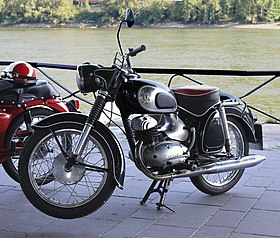DKW RT 200
The DKW RT 200 is the first motorcycle model from Auto Union to appear in the 200 cc class after the end of World War II. Among other brand motorcycles DKW the company from 1951 to 1958 built in Ingolstadt five RT models with two-stroke engines of 200 cc engine capacity in a total number over 60,000. The abbreviation RT in connection with the brand name DKW stands for Reich type and refers to the relationship to the rest of the Auto Union motorcycle model range.
The 200 class was still very popular in Germany in the 1950s, although there was no longer any objective or motor sport-related justification for this displacement: The times when 200 cc was the limit for tax and Driving license was 20 years ago.
From February 1951 to April 1952 the unsprung sidecar compatible model DKW RT 200 with a long-stroke 193 cm³ single-cylinder two-stroke engine of 8.5 HP, three-speed transmission and 19-inch wheels was produced. From June 1952 this engine was in the framework of the model RT 250 H with Geradweg rear suspension fitted with 40 mm travel and as RT 200 H sold. As part of the facelift at the end of 1953, the engine output rose to 9.7 hp thanks to an improved exhaust system.
From October 1954, the more powerful RT 200/2 followed with a short-stroke 11 hp engine, 4-speed gearbox and an improved chassis that was no longer suitable for sidecars; this model, which is not listed in the table below, was produced 15,689 times in one year. The successor model RT 200 S , available from October 1955, had the so-called spiked-rib cylinder with improved cooling, 18-inch wheels and a rear wheel swing arm with 95 mm of spring travel, as well as a starter carburetor, which made a dab to jump-start superfluous with the same engine power. Just like the larger RT 250, the RT 200 was also available from 1955/56 as the RT 200 VS with a front swing arm and a covered handlebar with integrated speedometer and headlights. A special feature of the VS is a headlight switch between solo and pillion rider operation (known as "headlight range control" in modern cars) and - a curiosity - in the last models the dummy shock absorber mounted next to the left rear strut for reasons of optical symmetry. After the Zweirad Union , founded in November 1958, took over the DKW motorcycle production , a few copies of the VS were made there.
Technical specifications
| model | DKW RT 200 (1951) |
DKW RT 200 H (1953) |
DKW RT 200 S (1957) |
DKW RT 200 VS (1957) |
|---|---|---|---|---|
| Engine: | 1-cylinder two-stroke with reverse scavenging | |||
| Displacement : | 193 cc | 198 cc | ||
| Bore × stroke: | 62 × 64 mm | 66 × 58 mm | ||
| Compression: | 1: 6.3 | |||
| Power: | 6.25 kW (8.5 PS) at 4200 rpm |
6.25 kW (8.5 PS) at 4500 rpm |
8.1 kW (11 PS) at 5000 rpm | |
| Transmission: | 3-speed | 4-speed | ||
| Sidecar compatible: | Yes | No | ||
| Front suspension: | Telescopic fork | Tuning fork with struts |
||
| Rear suspension: | no | Telescopic straight path suspension |
Swing arm with struts | |
| Wheelbase : | 1350 mm | 1278 mm | ||
| Tires: | 3.00–19 ″ | 3.00–18 ″ | ||
| Empty weight : | 116 kg | 133 kg | 131 kg | |
| Tank capacity: | 13 liters | k. A. | 15 liters | |
| Standard consumption (100 km): | 2.4 liters | 2.8 liters | ||
| Top speed: | 92 km / h | 103.5 km / h | ||
| Production period: | Feb. 1951 - April 1952 | June 1952–1954 | Oct 1955 - Oct 1956 | Oct 1956 - July 1958 |
| Number of pieces: | approx. 19,240 | approx. 28,797 | 5,938 | 5,389 |
| Base price: | 1,285 DM | 1,595 DM | 1,475 DM | 1,575 DM |
swell
- Catalog 100 motorcycles in words and pictures. Publishing house for trade and economy, Munich 1952
- DKW brochure from P. Flach, Bayreuth, AB 300 (451250)
- DKW brochure MB 514 (400 K 112 XX), 1957
- Siegfried Rauch: DKW - The story of a global brand. Motorbuch Verlag, Stuttgart 1988, ISBN 3-87943-759-9 .
- Ernst Leverkus: The great motorcycles of the 50s. Motorbuch Verlag, Stuttgart 1993, ISBN 3-87943-849-8 .


